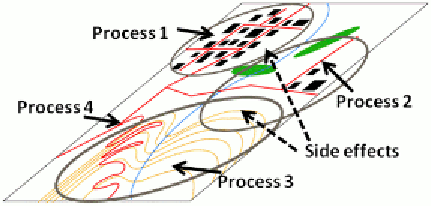Geoscience Reference
In-Depth Information
and Weibel 1988). Inspired from (Regnauld 2007) and (Duchêne and
Gaffuri 2008), the CG framework we define aims at allowing an answer to
the question
why
,
when
and
how
to apply
which
automatic process? Within
this framework, automatic generalisation processes are applied on parts of
space where they are expected to be efficient while side effects are likely
managed at generalisation neighbourhood (
Figure 1
).
Figure 1:
The collaboration principle between generalisation processes. A process 1 is car-
ried out on the town area, a process 2 on the rural area, and then a process 3 on the
mountain area and finally a process 4 is carried out on the road network. Side effects are
corrected at the neighbourhood (dashed arrows) of application spaces.
2.2 Overview of CG Framework Components
Generalising data within the CG framework brings about specific problems
like process interoperability, treatment heterogeneity or side effects (Touya
2008). The framework function analysis lead to a six main components
graphic spaces
where the
available generalisation processes
can be
applied. The
Translator
parameterises the processes. The
Registry
chooses
the process to generalise a given space. The
Observation
provides online
evaluation.
Side effects
are managed by the eponymous component.
Finally, the
Scheduling Component
orchestrates the whole process.

